When it comes to cooking healthy dishes, choosing the best cookware material becomes crucial. A good quality cookware material will help you get the most out of the food ingredients and make it even tastier. Your choice for the material of your cookware relies heavily on your cooking style and what you want to cook.
While most use stainless steel gas stoves for cooking, some have upgraded to glass top gas stoves, induction cooktops, electric stoves, or built-in ovens. Thus, the cookware materials must be compatible with these kitchen appliances.
There are quite a few cookware materials to choose from, including stainless steel, cast iron, aluminum, ceramic, copper, bronze, etc. In this article, know about the best healthy cookware materials with their ideal uses, pros, and cons.
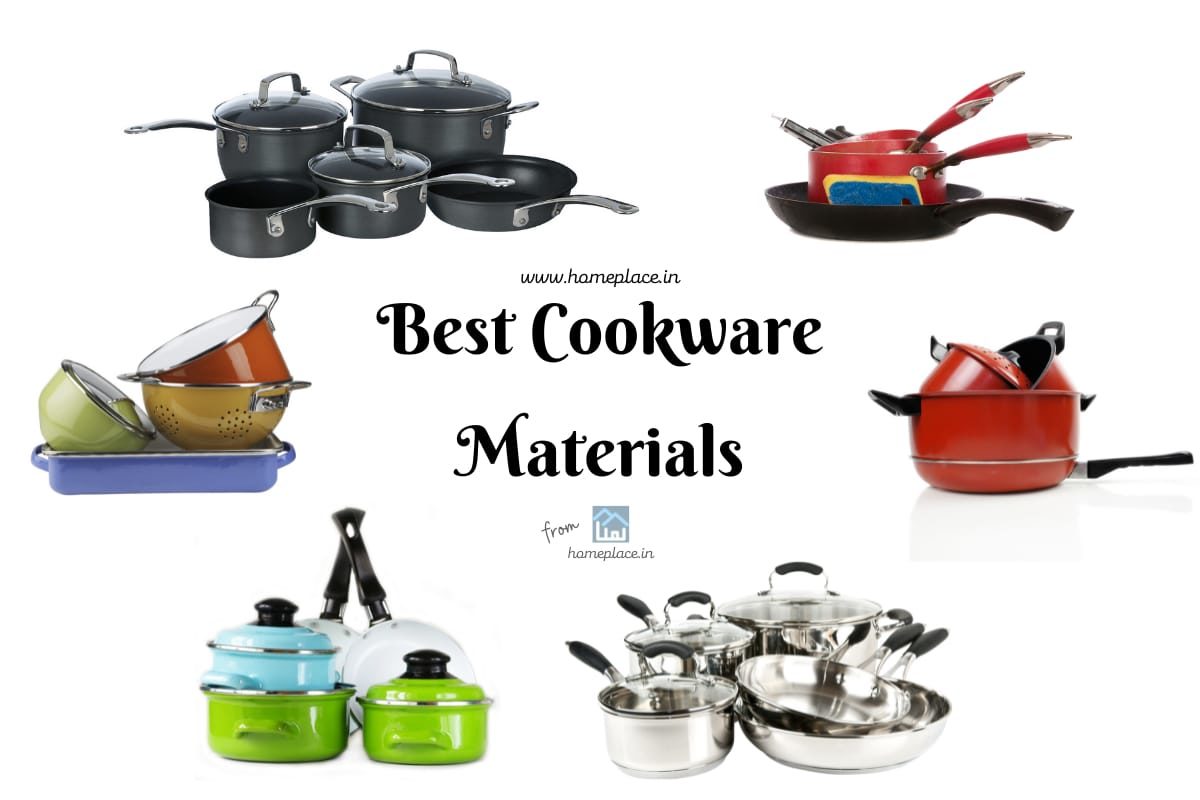
Best Cookware Materials for different uses
1. Stainless Steel
Stainless steel is very affordable yet lustrous and reliable for cooking. It is an alloy made up of at least 10.5% chromium and less than 1.2% carbon, along with other elements like nitrogen, aluminum, silicon, sulfur, titanium, nickel, copper, selenium, niobium, and molybdenum. As its name suggests, the key feature of this material is its anti-rust properties. The best stainless steel cookware is even more robust than ordinary iron.
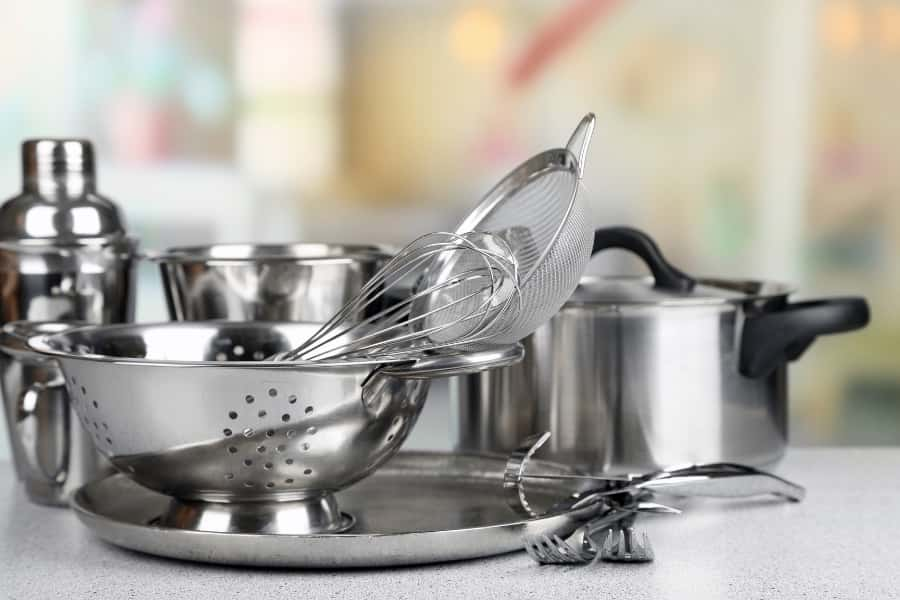
Uses:
- Kitchen sink, frying pan, cutlery, handi, dinnerware, saucepan, pressure cooker, tope, kadai, and containers that come to contact with water very frequently.
- SS 304 stainless steel is most suitable for cookware as it is food safe.
- SS 430 stainless steel is both gas and induction stove compatible, while all others are gas stove compatible.
Pros:
- Easy maintenance: Stainless steel is easy to clean. It can handle repeated rough use without getting visible scratches. When combined with the ease of cleaning, the material’s corrosion resistance makes this material ideal for use in cooking purposes.
- Highly conductive: The main expectation for the cookware material is to be a good heat conductor. Lucky for you, stainless steel has it. The molecular structure of stainless steel allows it to conduct heat efficiently for deep frying. Stainless steel is also very heat reactive, which means it heats and cools down pretty quickly. It gives you more control over the cookware.
- No transferred flavors: Stainless steel can withstand high amounts of heat without releasing its flavour into the food, and that alone makes it a perfect cookware material for regular cooking. So, no matter how high the temperature gets, the taste of your food won’t be spoiled by any means.
- Do not react with food: Stainless steel pans and kadais are food-safe and have no adverse effects. If you are looking for the safest cookware material for your health, it is good.
- Compatible with both gas and induction: Stainless steel with AISI 430 grade is ferromagnetic in nature. Many brands manufacture their utensils with SS 430 stainless steel at the bottom as it is the best material for induction cookware and electric stove.
Cons:
- Quality varies: There is not just one type of stainless steel in the market; its quality often goes with price. That depends on the dealer you’re buying the cookware from. Cheaper stainless steel cookware tend to warp and bend with time, while quality stainless steel cookware are reliable. You have to choose carefully.
- Too flashy: Sometimes, you may find shiny stainless steel cookware too vivid and unpleasant for the eyes. The luster of stainless-steel material makes it unsuitable for people who love the matte finish.
2. Cast Iron
Cast iron can be a beneficial cookware material if used correctly. It is a group of iron-carbon alloy with 2-4% carbon content. Cast iron may not be the best cookware material due to its brittleness and relatively low melting point. It can also change its shape when heated to high temperatures, which is not good. Overall, it’s a decent material suitable for use as cookware material.
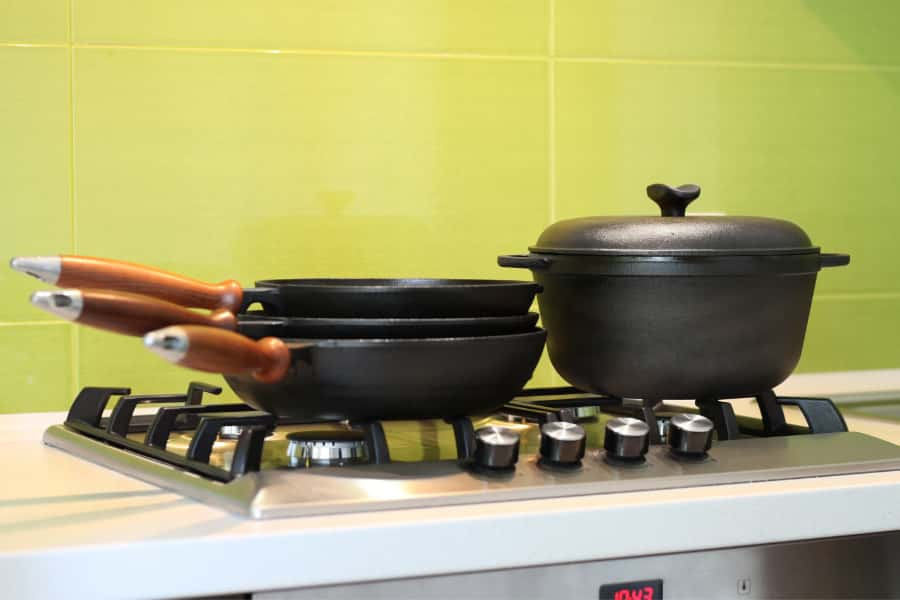
Uses:
Frying pan, Skillet, Dosa Tawa, etc.
Pros:
- Suitable for slow cooking: Cast iron has very high heat retention, longer than other materials, making it ideal for slow cooking. This high heat-retention property makes cast iron the best material for deep frying purposes.
- Non-sticky: The best cast iron cookware, on repeated use, can form a coating that acts as a natural non-sticking surface. Say goodbye to the expensive non-stick pans; cast iron has it naturally for a relatively low price.
- Adds iron to your food: Iron is not considered bad for our body, and it is an essential mineral our body needs regularly. Thankfully, cast iron tends to add some of its iron into the food that’s being cooked in cast-iron cookware. It makes the food even healthier and mineral-rich.
- Long lifespan: Cast iron has undoubtedly one of the most extended lifespans of all materials. You can expect years of reliable service from a cast iron cookware, longer than any other cookware material.
- Compatibility with induction and gas stove: Cast iron cookware is compatible with both induction cooktop and gas stoves. But it must have a flat bottom to work on induction.
Cons:
- Slow reaction to heat: Cast iron retains heat pretty well, but it is also very slow to heat and cool. Once the cast iron is hot enough, it takes a lifetime to cool down; it’s the same for the heating procedure. It takes very long to heat, which is not ideal for a cookware material.
- Heavy: Cast iron is undoubtedly very durable, but the durability makes this material considerably more severe than other materials. Like a grill pan made of cast iron, cookware can easily weigh more than 4.5 Kg on average. It makes cast iron cookware pretty hard to carry around.
- High maintenance: Cast iron is not resistant to corrosion and can lose its non-stick properties if not cared for properly. Even a simple everyday task like washing needs to be done with special care in cast iron cookware; else, it will catch rust easily.
Also Read: Best Non-Stick Cookware in India
3. Copper
Copper is known for its conductivity of heat and electricity, making it an ideal cookware material. It rests at number 29 on the periodic table with Cu as its symbol and has excellent thermal conductivity. Apart from being a great conductor of heat and electricity, copper is very malleable and ductile, making it one of the best cookware materials.
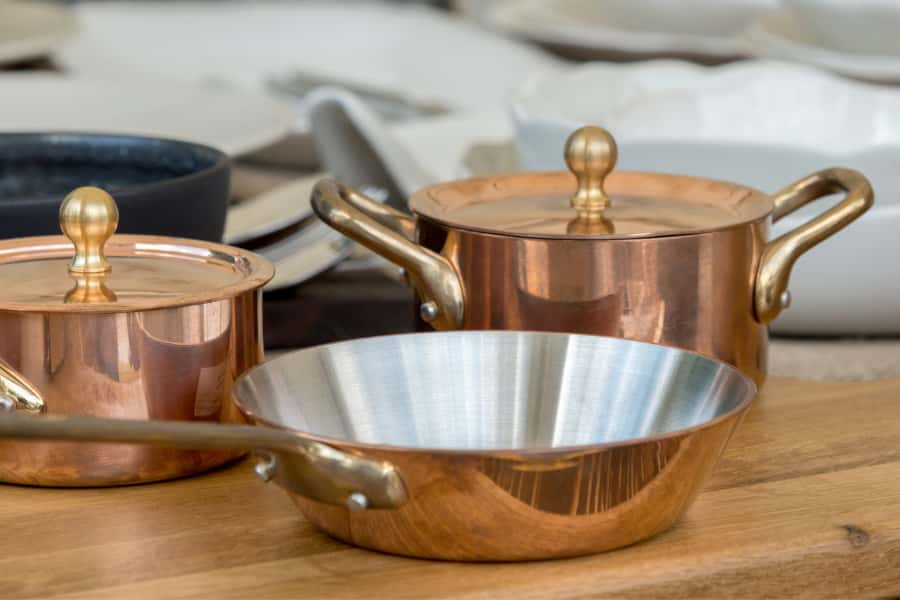
Uses:
Kadai, wok, pot, pans, bottle, etc. (Related: Wok vs. Kadai)
Pros:
- Highly conductive: Copper is a great conductor of heat and electricity, which means there will be very little heat loss while cooking. High conductivity also results in better heat distribution throughout the utensil, making your food cook firmly from each side.
- Heat reactive: Copper utensils are quick to heat up and cool down, which means they are heat reactive. Cookware made of copper is ideal when hunger calls as they quickly get ready for cooking.
- Elegant looking: Apart from its features, copper utensils are a pleasure to look at. No doubt they’re the first choice of chefs from around the world.
Cons:
- Pricey: With great features and benefits comes an even greater price tag. Copper cookware is the most expensive of them all, affecting its accessibility.
- High maintenance: Copper can undergo oxidation and develop an ugly-looking green layer if not correctly cared for. Therefore, copper cookware requires higher maintenance than most materials.
- Heavy: Copper utensils are severe; a single skillet of medium size can weigh over 3 pounds. It affects the portability of cookware made of copper to a great extent.
- Compatibility: While copper is fine to work on gas stoves, it is incompatible with induction stoves.
4. Hard anodized Aluminum
Aluminum is the most widely used metal globally, which is not iron or doesn’t include iron in any form. Aluminum is the most abundant metal in the earth’s crust and has an atomic number of 13. When aluminum is placed in an acidic solution, and an electric current is passed through it, a layer of aluminum oxide is formed on the metal, acting as a hard, non-stick surface.
Aluminum can leach into the food when exposed to ingredients with low pH. Anodization of aluminum is done to prevent it from doing just that. Thus, it is always preferred to use the best hard anodized cookware instead of regular aluminum.
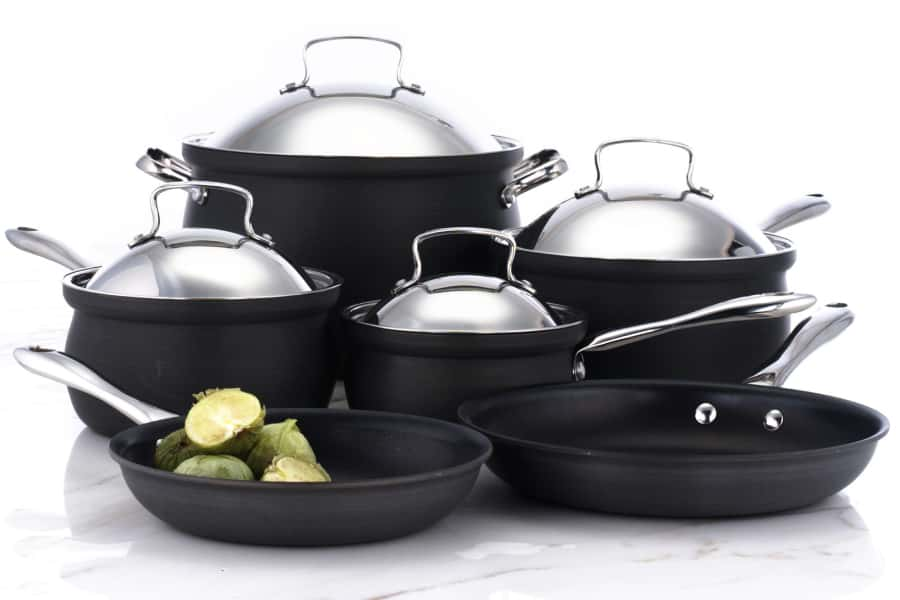
Uses:
Roti tawa, saucepan, frying pan, wok, kadai, etc.
Pros:
- Lightweight: Utensils made of anodized aluminum are lightweight than any other cookware material. It makes the aluminum cookware portable.
- More substantial than steel: Hard anodized material can be even more potent than steel in most cases.
- Resistant to corrosion: The thin aluminum oxide layer makes the metal utterly resistant to deterioration and salt. This resistance to corrosion and salt reduces the maintenance efforts overall.
- Naturally non-sticky: The aluminum-oxide layer formed during the anodization process makes the utensil made of anodized aluminum non-sticky.
Cons:
- Requires special care: We must prevent scratches on hard-anodized aluminum to avoid corrosion. It needs special care while storing them as it can easily get scratched by other utensils if stored carelessly.
- Incompatibility: Hard anodized aluminum works well on gas stoves, but you cannot use it on induction or clean it in a dishwasher.
5. Ceramic
Ceramic cookware boasts the health benefits that might be true. However, ceramic cookware is not entirely made of ceramic; it’s just a sol-gel coating on metal that makes it completely non-sticky. This coating leaches silicone oil every time the cookware is heated, mimicking a non-stick surface.
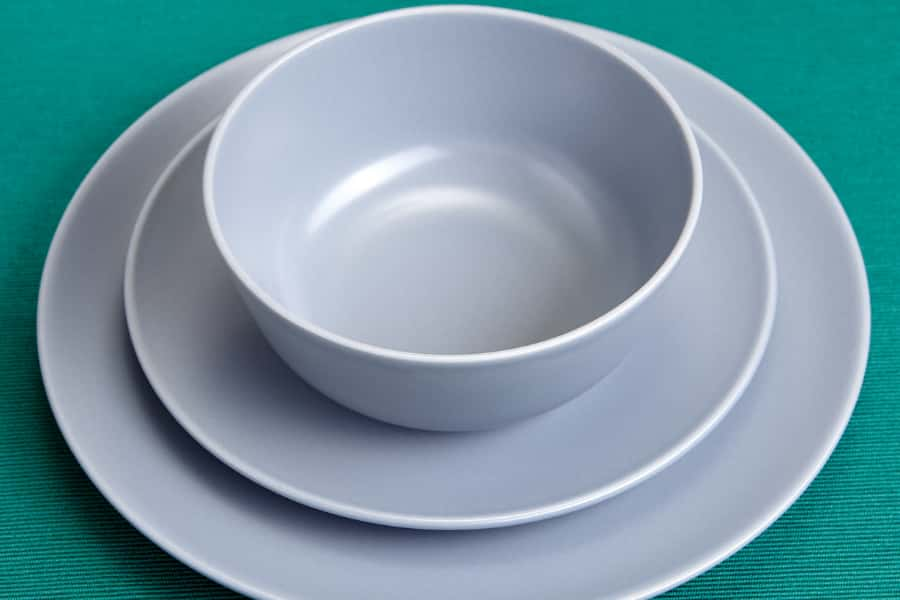
Use:
Pottery, kadai, casserole, pressure cooker, etc.
Pros:
- Non-sticky: The best ceramic cookware is entirely non-sticky. The sol-gel coating on these cookware releases silicon oil, making the surface completely non-sticky. You can get the same result with steel or iron cookware, but you will have to use oil or butter as a lubricant, which increases your food’s fat quantity.
- Easy to clean: Cooking on a non-stick pan is always a treat; the ceramic coating works as a lubricant like oil. This makes it easy to clean this non-stick cookware.
- Energy-efficient: Ceramic-coated cookware gets heated quickly, which means very little heat is lost during the cooking process.
- Ideal for reheating and storing food: Ceramic naturally resists bacteria buildup, making ceramic cookware ideal for storing and reheating food.
Cons:
- Lacks durability: The ceramic coating is not very durable. It tends to get damaged with repeated use. Once that coating is removed even partially, the cookware loses its non-stick properties, and the surface becomes sticky for almost every type of food.
- Needs special care: Although it is effortless to wash ceramic coated cookware, the washing must be done with special care; else, the ceramic coating will get damaged, and the cookware will lose its non-stick properties. It would also help avoid scratches on the ceramic coating; you must store this cookware with care.
- Cannot handle high heat: The ceramic coating gets damaged when exposed to very high heat settings. It results in the loss of non-stick properties. Ceramic cookware can only handle low to medium amounts of heat.
- Ceramic cookware is compatible with gas stoves and sometimes microwave ovens. But they do not work on induction unless they have an induction bottom.
6. Bronze
Bronze is a copper alloy with an addition of 12-15% tin and some aluminum or zinc. It can also be mixed with some non-metals like silicon as per requirements. As per Ayurveda, Kansa or bronze is beneficial to sharpen intellectuality, improve immunity and hemoglobin, pacify Pitta, and help in digestion. It is one of the best cookware materials for health as it does not readily react with acidic food. However, cookware made of bronze feels 10% heavier when compared with stainless steel cookware of the same size.
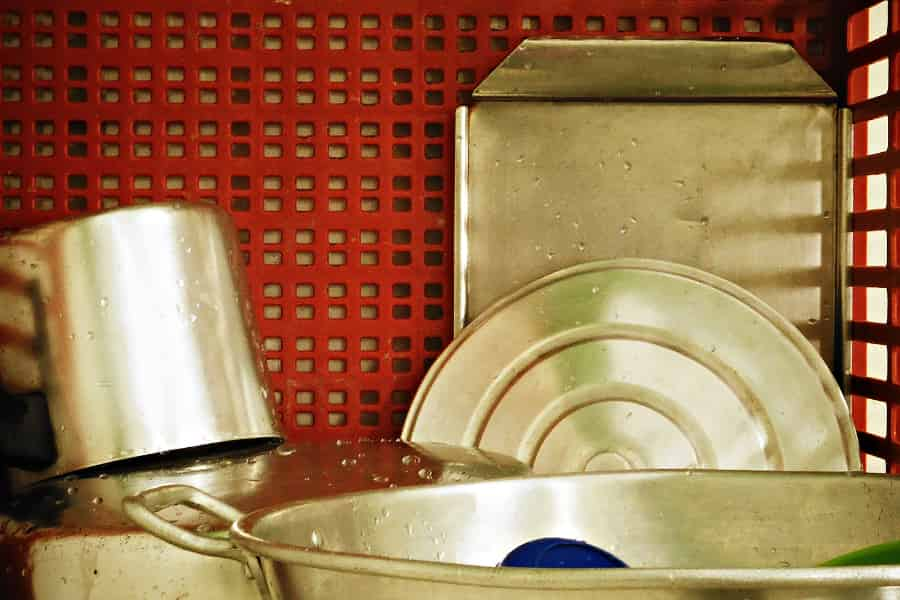
Use:
Kadai, wok, plate, glass, etc.
Pros:
- Lightweight: Bronze cookware of the same size feels weightless compared to other metal cookware. This makes it highly portable and suitable for carrying around for camping purposes.
- Health benefits: Scientists have proven health benefits relating to cooking and eating in bronze utensils. The copper present in bronze increases hemoglobin, whereas tin improves digestion. Bronze is also known to improve brain function and help in fighting cardiovascular diseases.
- Durable: Good quality bronze is very durable while being lightweight. You can expect years of reliable service from bronze cookware.
- Gas stove compatible: Bronze cookware work well on gas stoves, but as bronze is not a ferromagnetic material, you cannot use it on induction stoves.
Cons:
Special care required: Bronze undergoes oxidation frequently, forming a green ugly-looking layer on the utensil. It then needs to rest in tamarind water to remove oxidation.
7. Granite
Granite is an igneous rock formed from magma and has a high silica content and alkali metal oxides. It mainly consists of quartz, alkali feldspar, and plagioclase. However, when it comes to granite cookware, it does not contain granite.
It is steel cookware covered with fused glass to create a non-stick surface. The look of granite cookware resembles the texture of granite rock, and that’s where it got its name. Granite cookware is your ideal choice if you are looking for the best cookware with attractive designs and colors.
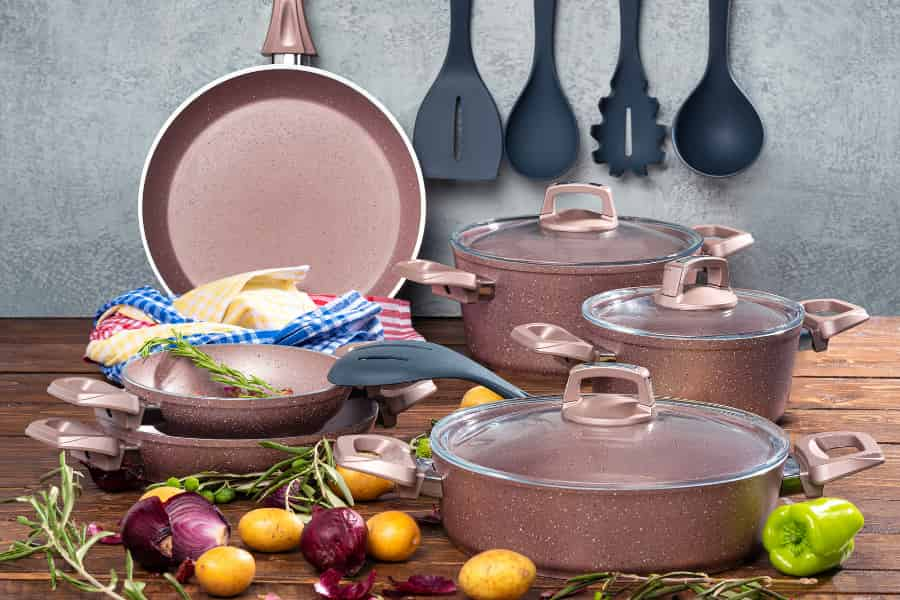
Uses:
Saucepan, frying pan, wok, kadai, etc.
Pros:
- Lightweight: As said, granite cookware is not made of heavy granite rock. Instead, they’re made of stainless steel and glass, making them very lightweight than a cast iron cookware of the same size.
- Elegant looking: The look and texture of granite cookware is aesthetically pleasing to the eye. Some people prefer granite cookware as it enhances the look of your modern modular kitchen in every way.
- Resistant to rust: Since granite cookware is made of stainless steel and covered by glass, they are entirely immune to rust. This makes granite cookware more preferable to cast iron cookware.
- Safe for acidic dishes: Granite cookware is entirely neutral, unlike most metals that can react to sour dishes. You can prepare acidic dishes safely in granite cookware without worrying about health risks. Enameled granite cookware is safe for cooking.
- Modern granite cookware has an induction bottom, making them compatible with both induction and gas stoves. They look best in modular kitchens with a glass top gas stove or hob.
Cons:
- Metal cookware can chip the enamel: The fused glass layer can be easily chipped by metal utensils if not taken correctly. The non-stick properties will be lost once the enamel gets chipped off.
- Not very durable: The coating on the stainless-steel core is not very stable and gets damaged with repeated use. Once that coating is gone, almost every type of food will start sticking to the surface.
- Fewer design choices: While granite cookware is one of the most elegant-looking ones, the design choices are minimal. Most granite cookware look the same; you will have difficulty finding different designs among them.
8. Clay
Clay is a natural soil, fine-grained and filled with clay minerals. It remains like normal sand when dry; it only develops plasticity when wet. Clay is one of the oldest materials used in making pottery. It induces an aroma in the food that one cannot forget when it comes to cookware.
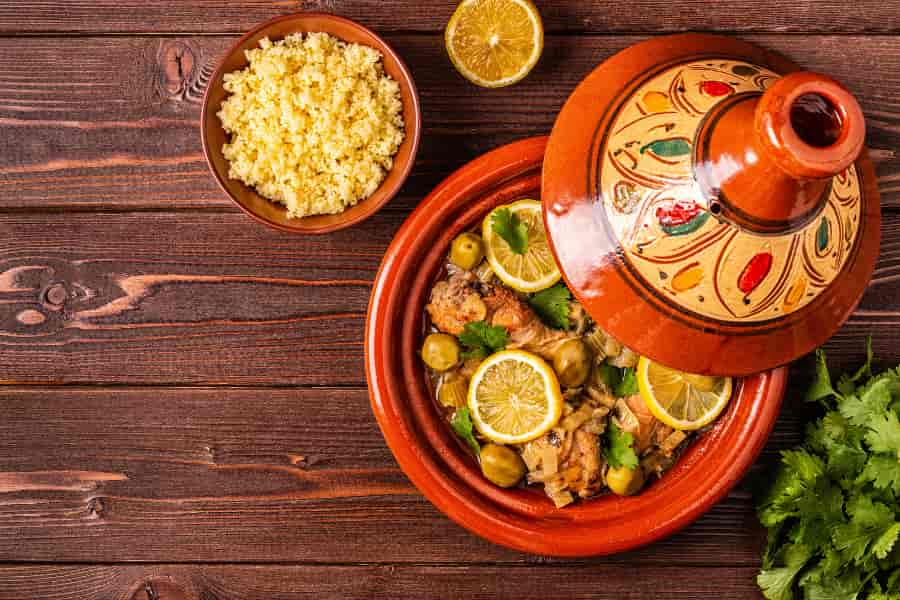
Use:
Pottery, kadai, wok, pot, and pan.
Pros:
- Induces an earthy flavour in the food: Food cooked in a clay pot has a simply unbeatable aroma. It also adds an earthy taste to the food, making it even tastier.
- Beneficial to health: Clay pots do not release any chemicals on the food, making it one of the best cookware materials for healthy cooking.
- Affordable: Cookware made of clay are very economical compared to other cookware materials.
Cons:
- Fragile body: The body of clay pots is tender; just a regular jerk is enough to break the pot into pieces. Clay pots are weak and thus require special care to store and move.
- Not very efficient: Clay is not a good conductor of heat; a considerable amount of heat is lost during cooking. It results in a massive loss of energy, and food takes a long time to cook.
- This type of cookware is incompatible with induction cooktops or electric stoves. You must be cautious about using them on gas stoves as uneven heat distribution may damage them.
How to Select the best Cookware Material for cooking?
Your choice of cookware material depends greatly on which type of food you want to cook in that cookware. It must be your rule of thumb in Cookware material Comparison, along with a few other aspects that are as follows:
- Budget: Everything starts with setting a budget. It’s probably the most crucial factor you need to consider when buying cookware. Choose the cookware material which fits your budget.
- Heat reactivity: Heat reactivity is how much time the cookware requires to heat up or cool down. If you’re the one who wants the food to be cooked as soon as possible, you should go with the material that is highly reactive to heat, like stainless steel.
- Heat conductivity: Heat conductivity also relates to the heat distribution and the efficiency of the cookware material. The higher the conductivity of the cookware, the better the food will cook. Materials such as stainless steel and copper have remarkable heat conductivity and a hefty price tag.
- Durability: You don’t want your cookware to become useless in a few months. You should choose the material which can handle slightly rough usage and require low maintenance. Materials like cast iron and stainless steel are highly durable.
- Health Benefits: Before buying cookware, you must ensure it is food-safe and does not react with the ingredients. Cast iron and stainless steel cookware have the most health benefits.
Cookware material – Final verdict
So, the choice of cookware material is subjective in most cases, and there is no rule of thumb that is 100% accurate. You have to consider many factors to have perfect cookware that suits all your needs.
You must be wondering why there is so much fuss about choosing suitable cookware material?
If you pick the wrong one, you might mess up your food which is the last thing you’ll want to do when hungry. Factors like durability, budget, and conductivity play a key role in choosing the best cookware material, and good quality utensils for cooking are made of these materials.
Selecting the suitable cookware material for you isn’t a hard choice either; it’s just that it can save you a lot of time and money if you make the right choice.
Related Post:
